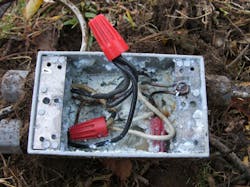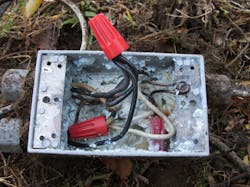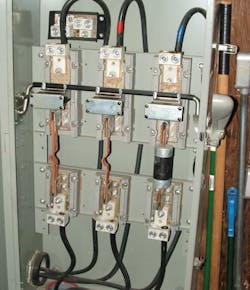Illustrated Code Catastrophes: Sections 314.15, 300.5(B), 300.6(B), and 240.21(A) through (H)
All references are based on the 2011 edition of the NEC
Wet and Wild!
I discovered this buried aluminum box full of moisture when I removed its cover. The trapped moisture had caused severe corrosion to the box as well as the wiring, which arced and tripped the circuit breaker.
Section 314.15 requires boxes, conduit bodies, and fittings to “be placed or equipped so as to prevent moisture from entering or accumulating within the box, conduit body, or fitting.”Clearly, that did not happen here, and the result was a gooey mess of corrosion. In addition, the twist-on wire connectors used in this box were not specifically designed for use in a wet location. According to Sec. 300.5(B), “any connections or splices in an underground installation shall be approved for wet locations.”
Lastly, Sec. 300.6(B) requires installers to provide supplementary corrosion protection for “aluminum raceways, cable trays, cablebus, auxiliary gutters, cable armor, boxes, cable sheathing, cabinets, elbows, couplings, nipples, fittings, supports, and support hardware embedded or encased in concrete or in direct contact with the earth.”
The installer should have installed a small, nonmetallic handhole in place of the aluminum box and used wet location-rated twist-on wire connectors.
Is There a Plumber in the House?
I found this surprise during an infrared thermal scan. Just as some people replace a blown Edison-based fuse with a copper penny, somebody replaced these fuses with copper plumbing pipe hangers. This created a very dangerous situation, since these wires were essentially left with no overcurrent protection.
Most of us know that a fuse or circuit breaker is required to be installed in series with each ungrounded conductor. In accordance with 240.21, “overcurrent protection shall be provided in each ungrounded circuit conductor and shall be located at the point where the conductors receive their supply except as specified in 240.21(A) through (H).” Nowhere in (A) through (H) is there any mention of copper strap pipe hangers being an approved overcurrent protective device.
Because this feeder was supplying power to two elevators, we could also make reference to Art. 620. In accordance with 620.61(C), “Motor feeder short circuit and ground fault protection shall be as required in Art. 430, Part V.” Sections 430.61 and 430.62 require that this feeder be provided with a protective device to protect against short circuits and ground faults. There are no exceptions that would ever allow the use of pipe hangers in place of fuses.
About the Author

Russ LeBlanc
Owner
Russ started in the electrical trade as an apprentice in 1985. He worked his way up to become a Journeyman Electrician and then eventually became a Master Electrician and Licensed Construction Supervisor. In 1999 Russ become an Electrical Instructor for The Peterson School of Engineering in Massachusetts where he developed his passion for teaching, and quickly became Department Head of Electrical Instruction. Russ has taught thousands of apprentices, electricians, engineers, inspectors, and other electrical professionals during his career as an instructor. He continues to provide electrical professionals with Electrical Code seminars, Arc-Flash Awareness training seminars and educational material through his LeBlanc Consulting Services in North Reading, MA whose specialty is educating electricians. He has been an active member of the NFPA Electrical Section and has authored hundreds of National Electrical Code proposals and comments which have become Code rules to improve the safety for the electrical industry. Russ is also an IAEI certified Electrical Inspector.
Please visit www.russleblanc.net for more information.


